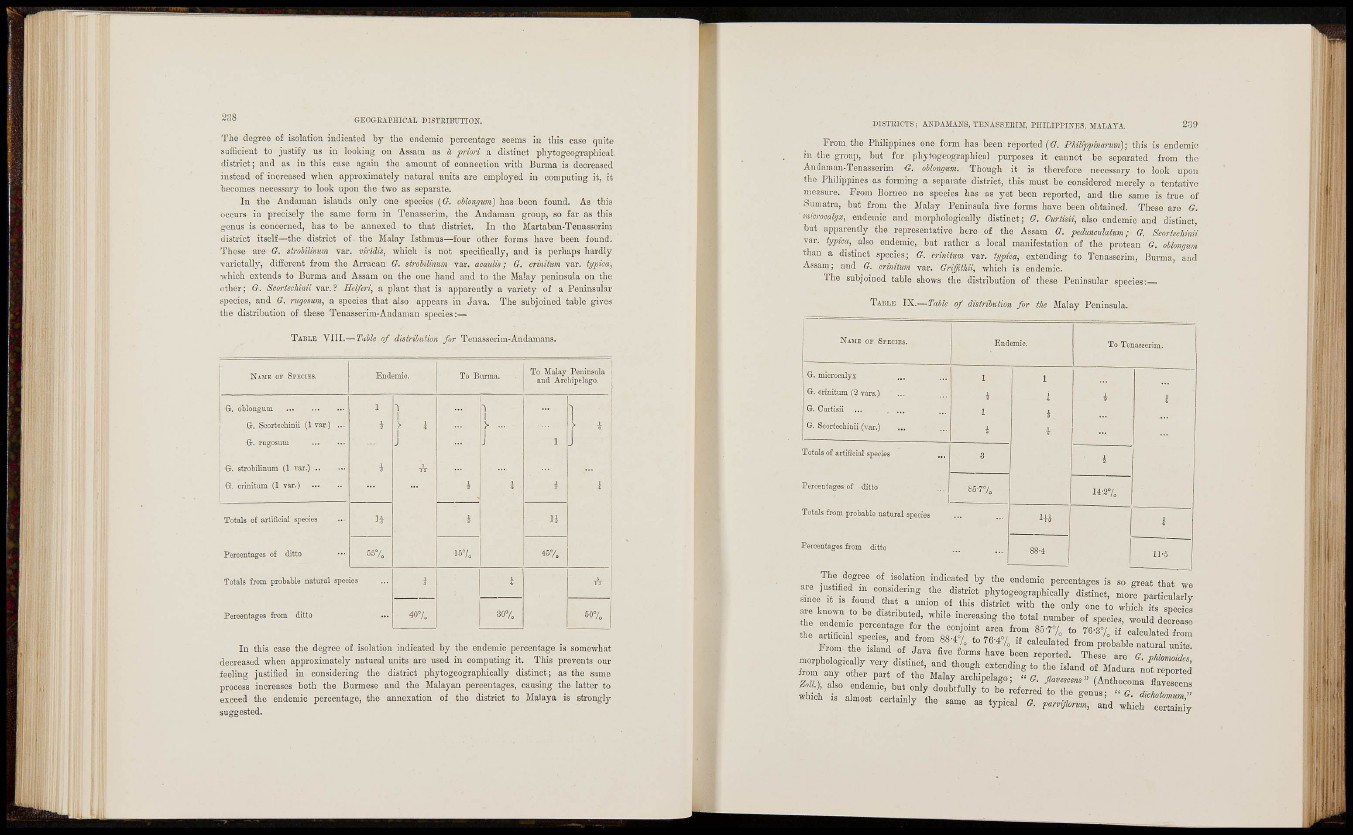
2 3 8 G E O G E A P H I C A L DISTERBOTIO^'.
The degree of isolatioii indicated by the endemic percentage seems in this case quite
sufficient to justify us in looking on Assam as ^ ¡mori a distinct pliytogeograpliical
district; and as in this case again the amount of cojinection with Burma is decreased
instead of increased when, approximately natural units are employed in computing it, it
becomes necessaiy to look upon the two as separate.
In the Andaman islands only one species ((?. oUon^um) has been found. As this
occurs ia precisely the same form in Tenasserim, the Andaman group, so far as this
^•enus is concernedj has to be annexed to that disti-ict. In the Martaban-Tenasserini
district itself—the district of the Malay Isthmus—four other forms have been found.
These are G. alrobilinum var. viridis, which is not specifically, and is perhaps hardly
varietally, different from the Arracan G. siroUlimni var. acaulk; G. crinitum var. typca,
which extends to Burma and Assam on the one hand and to the Malay peninsula on the
other; <?. Seoriechinii var. ? Hdferi, a plant that is apparently a variety of a Peninsular
species, and G. rugosum, a species that also appears in Java. The subjoined table gives
the distribution of these Tena^erim-Audanian species:—
TABLE VIII. — Table of distribution for Tunasserim-Andamans.
NAME OF SPECIES. Endemia. To Etirma. To Malay Peninsula
and Arcliii)elago.
G. obloDguni
G. Saortechinii (1 rar.) ...
G. rugosum
1
Ì
Ì
[
J
T
1
!• ••
1
J 1 } •
G. strobilinum (1 var.)
G. crinitum (1 vtir.)
i TV
i Ì i
Total s of artificial species n J H
Percentages of ditto 1 5 7 . 4 5 %
Totals fi'om probable natural spec ies i Ì
Percentages from ditto « 7 . 307„ 5 0 %
In this case the degree of isolation indicated by the endemic percentage is somewhat
decreased when approximately natural units are used in computing it. This prevents our
feeling justified in considering the district phytogeographically distinct; as tiio same
process increases both the Burmese and the Malayan percentages, causing the latter to
the endemic percentage, the annexation of the district to Malaya is strongly
D I S T E I C T S i ANDAMANS, TE^^XSSEEIM, rHILIPPINES, MALAYA. 23 9
Fi-om the Philippines one form has been reported ((?. Philippinarum)-, this is endemic
?n the group, but for phytogeographical purposes it cannot be separated from the
Andanvan-Tenasserim G. oblongum. Though it is therefore necessary to look upon
tlie Philippines as forming a separate district, this must be considered merely a tentative
measure. From Borneo no spccies has as yet been reported, and the same is true of
Sumatra, but from the Malay Peninsula five forms have been obtained. These arc G.
microcalgx, endemic and morphologically distinct; G. Curtisii, also endemic and distinct,
but apparently the representative hei-e of the Assam G. pedunculatum; G. Scortcchinii
var. typica, also endemic, but rather a local manifestation of the protean G. oblongum
than a distinct species; G. crinitum var. ii/piea, extending to Tenasserim, Burma, and
Assam; and G. crinitum vs.r. GriffithU, which is endemic.
The subjoined table shows the distribution of these Peninsular species; —
TABLE IX.—Tabic of distribution for the Malay Peninsula.
j NAME OF SPECIES. Endemic. T o TenasEeiim.
G. mierooalys .. .
G. crinitum (2 vars.)
G. Curtisii
G, Seoriechinii (var.)
1
I
1
i
1
i
4 i
Totals of ai'tifieial species 3 i
Percentages of ditto 6 5 - 7 % 1 4 ' 2 7 .
Totals from probable natural species
i
Percentages from ditto
88 4 11-5
of isolation indicated by tho endemic percentages is so great that w,.
s £„:„ f; ™ ' p'^^-togeog^pMoii,, d i e , . „ . f p 1 1 : ;
r „ t , r . / -""y O"» '•> its species
.3 .taose eert.;.,, .te . . e as ..pica. »<1 wMc. t S ;